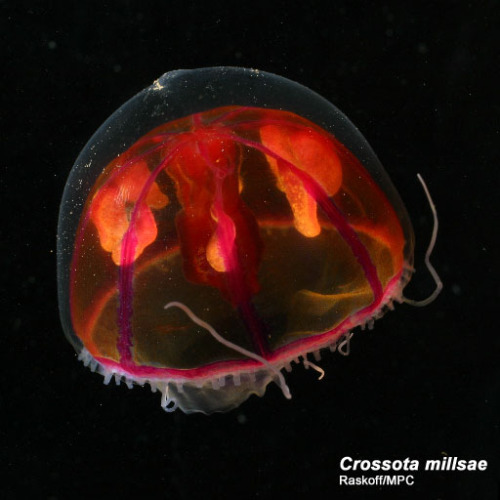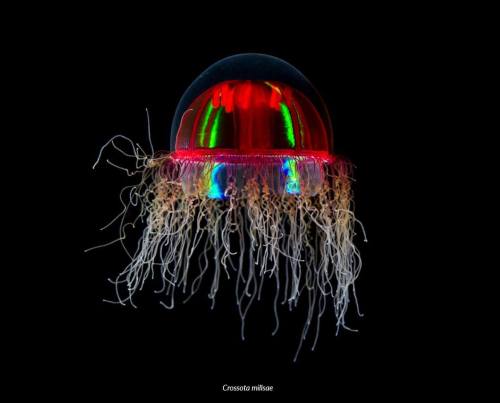Your gateway to endless inspiration
Hydrozoa - Blog Posts


Mid-water Arctic Hydrozoan
Botrynema brucei
The Mid-water Arctic Hydrozoan is a mini-jelly that is transparent with hints of blue. It thrives in freezing cold temperatures and drifts aimlessly in the Artic Ocean. Moreover, it is only 3 cm in size and floats between 900m to 2,600m.
Photo credit: https://en.wikipedia.org/wiki/Botrynema_brucei
http://www.arcodiv.org/watercolumn/cnidarian/Botrynema_brucei.html


Psychedelic Medusa
Crossota millsae
The Psychedelic Medusa is a deep-sea hydrozoan that is abundant in the North Pacific. The mini-jelly is found at depths between 1000m to 3800m, and are often observed drifting near the ocean floor. It also has an eccentric reproduction behavior uncommon in cnidarians. The females display viviparity, and carry the babies in her bell until they are ready to hatch.
Photo credit: http://www.arcodiv.org/watercolumn/cnidarian/Crossota_millsae.html
https://twitter.com/spothvegr/status/1030177493075079169


Giant Bell Jelly
Scrippsia pacifica
The Giant Belly Jelly has 256 tentacles attached to a gelatinous bell-shaped base. Like most cnidarians, the Giant Belly Jelly uses specialized stinging cells called nematocysts to catch its prey. When fish and other prey swim into its tentacles, the sensory projection on the cnidocyte (cell that holds the nematocysts) is activated. Then the nematocysts and barb are released, hitting the vulnerable prey and releasing a toxin into the prey’s body. The Giant Bell Jelly is found at 400 m in the ocean. It is related to the jellyfish, but it is categorized as a Hydrozoa (similar to the Portuguese- man-o-war)
https://vimeo.com/42551565
Photo Credit: https://www.pinterest.cl/pin/467107792572034837/
https://courses.lumenlearning.com/ivytech-bio1-1/chapter/phylum-cnidaria/